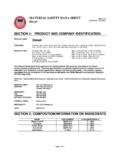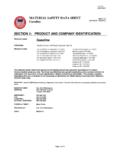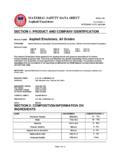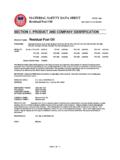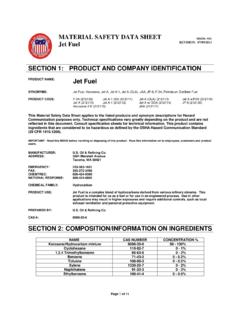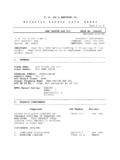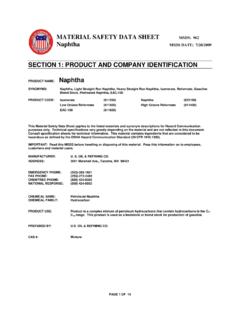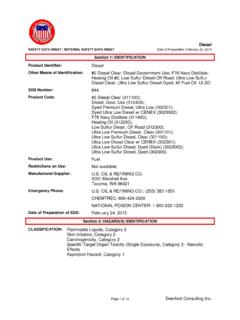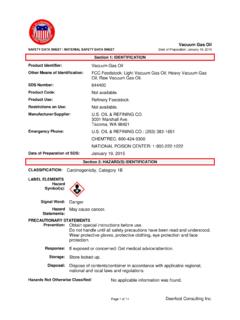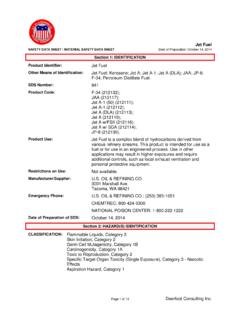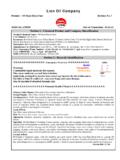Transcription of MATERIAL SAFETY DATA SHEET MSDS: 955 …
1 Page 1 of 11 MATERIAL SAFETY data SHEET msds : 955 Marine Distillate REVISION: 04/01/2012 SECTION 1: PRODUCT AND COMPANY IDENTIFICATION PRODUCT NAME: Marine Distillate Fuel Oil, All Grades SYNONYMS: Marine Diesel Oil, MDO, Marine Gas Oil, MGO, Marine Diesel Fuel, Marine Distillate Fuel, DMA, DMB, DMC PRODUCT CODE: ISO-DMB (411000) Marine Gas Oil DMA, Dyed (302500) Marine Diesel Oil High (421000) Marine Gas Oil High Clear (321500) Marine Gas Oil Low Dyed (312500) This MATERIAL SAFETY data SHEET applies to the listed products and synonym descriptions for Hazard Communication purposes only. Technical specifications vary greatly depending on the product and are not reflected in this document. Consult specification sheets for technical information. This product contains ingredients that are considered to be hazardous as defined by the OSHA Hazard Communication Standard (29 CFR ).
2 IMPORTANT: Read this msds before handling or disposing of this product. Pass this information on to employees, customers and product users. MANUFACTURER: Oil & Refining Co. ADDRESS: 3001 Marshall Avenue Tacoma, WA 98421 EMERGENCY: 253-383-1651 FAX: 253-272-2495 CHEMTREC: 800-424-9300 NATIONAL RESPONSE: 800-424-8802 CHEMICAL FAMILY: Hydrocarbon PREPARED BY: Oil & Refining Co. CAS #: 68476-34-6 SECTION 2: COMPOSITION/INFORMATION ON INGREDIENTS NAME CAS NUMBERCONCENTRATION %Petroleum Distillate 68476-34-680 100% Fuel Oil, Residual 68476-33-50 20% Naphthalene 91-20-30 Page 2 of 11 SECTION 3: HAZARDS IDENTIFICATION Warning!
3 Combustible. Mist or vapors can cause a flash fire. Liquid, mist or vapors can cause eye, skin and respiratory tract irritation. Ingestion or liquid aspiration into the lungs can result in chemical pneumonia. This product may contain or release Hydrogen sulfide which is a highly toxic, highly flammable gas which can be fatal if inhaled at certain concentrations. This product may also contain polycyclic aromatic oils which may be carcinogenic to humans. PHYSICAL STATE: Liquid COLOR: Varies, clear, yellow (pale to straw), greenish-yellow, red, green color, black. ODOR: Faint Petroleum Odor ROUTES OF ENTRY: Dermal Contact, Eye Contact, Inhalation, Ingestion POTENTIAL HEALTH EFFECTS: EYES: Eye irritation may result from contact with liquid, mists and/or vapors.
4 Effects may become serious with repeated or prolonged contact. SKIN: Contact with the skin may cause irritation. Prolonged contact may cause dermatitis. Repeated contact may cause harmful effects in other parts of the body. INGESTION: This MATERIAL can irritate the mouth, throat, and/or stomach. Aspiration into the lungs may cause chemical pneumonia. In severe cases loss of consciousness may occur. INHALATION: Vapors or mists can irritate the nose, throat and/or lungs. Breathing high concentrations can cause dizziness, headache and vomiting or loss of consciousness. Hydrogen sulfide can evolve from this product, which can cause dizziness, nausea, headache or death. MEDICAL CONDITIONS GENERALLY AGGRAVATED BY EXPOSURE: This product contains petroleum distillates similar to those shown to produce skin tumors on laboratory animals.
5 Avoid prolonged or repeated skin contact. OVER-EXPOSURE SIGNS/SYMPTOMS: Headache, severe eye irritation, nausea, dizziness, damage to central nervous system, respiratory depression, convulsions, or loss of consciousness. See toxicological information (section 11) Page 3 of 11 SECTION 4: FIRST AID MEASURES EYES: Flush eyes with plenty of water for a minimum of 15 minutes. Seek medical care if irritation persists. SKIN: Flush skin with plenty of water for at least 15 minutes while removing contaminated clothing and shoes. Get medical attention if irritation develops. Launder or dry-clean clothing prior to re-use. INGESTION: WARNING! DO NOT INDUCE VOMITING. If aspirated into the lungs, may cause chemical pneumonitis. Seek medical attention immediately.
6 INHALATION: If inhaled, remove to fresh air. If breathing is difficult, give oxygen. If not breathing, give artificial respiration. Get immediate medical attention. NOTES TO PHYSICIANS OR FIRST AID PROVIDERS: Ingestion/Inhalation of this product or subsequent vomiting may lead to aspiration, which may cause pneumonitis. Page 4 of 11 SECTION 5: FIRE-FIGHTING MEASURES FLAMMABILTY OF THE PRODUCT: Combustible liquid Flammable limits in air (% by volume) LOWER: Approx UPPER: Approx FLASH POINT: Approximately 60 C, (140 F) AUTOIGNITION TEMPERATURE: Approximately 257 C (495 F) PRODUCTS OF COMBUSTION: Normal combustion forms water vapor and carbon dioxide. Incomplete burning can produce carbon monoxide and particulate matter. FIRE HAZARDS IN THE PRESENCE OF VARIOUS SUBSTANCES: Combustible liquid.
7 When heated above the flash point, this MATERIAL will release vapors that can ignite when exposed to open flame, sparks and static discharge. Mists or sprays may be flammable at temperatures below the normal flash point. Keep away from heat and open flame. FIRE-FIGHTING MEDIA AND INSTRUCTIONS: Combustible Liquid. Use dry chemical, foam or carbon dioxide to extinguish the fire. Consult foam manufacturer for appropriate media, application rates and water/foam ratio. If a leak or spill has not ignited, ventilate area and use water spray to disperse gas or vapor and to protect personnel attempting to stop a leak. Use water to flush spills away from sources of ignition. Do not flush down public sewers. Collect contaminated fire-fighting water separately. It must not enter the municipal sewage system.
8 Dike area to prevent runoff. Decontaminate emergency personnel and equipment with soap and water. Combustible liquid and vapor. Vapor may cause flash fire. Vapors may accumulate in low or confined areas or travel a considerable distance to a source of ignition and flashback. Runoff to sewer may create fire or explosion hazard. SPECIAL FIRE FIGHTING EQUIPMENT: Fire-fighters should wear appropriate protective equipment and self-contained breathing apparatus (SCBA) with a full face-piece operated in positive pressure mode. Cool tanks, containers and exposed structures with water. UNUSUAL FIRE & EXPLOSION HAZARDS: Moderately combustible. When heated above the flash point, this MATERIAL will release flammable vapors which if exposed to a source of ignition can burn or be explosive in confined spaces.
9 Mists or sprays may be flammable at temperatures below the normal flash point. Keep away from heat and open flame. Page 5 of 11 SECTION 6: ACCIDENTAL RELEASE MEASURES PERSONAL PRECAUTIONS: Immediately contact emergency personnel. Eliminate all ignition sources. Keep unnecessary personnel away. Use suitable protective equipment (section 8). Do not touch or walk through spilled MATERIAL . Tanks, vessels or other confined spaces which have contained product should be freed of vapors before entering. The container should be checked to ensure a safe atmosphere before entry. Empty containers may contain toxic, flammable/combustible or explosive residues or vapors. Do not cut, grind, drill, weld or reuse empty containers that contained this product. Do not transfer this product to another container unless the container receiving the product is labeled with proper DOT shipping name, hazard class and other information that describes the product and its hazards.
10 ENVIRONMENTAL PRECAUTIONS: Avoid dispersal of spilled MATERIAL and runoff and contact with soil, waterways, drains and sewers. If facility or operation has an "oil or hazardous substance contingency plan", activate its procedures. Stay upwind and away from spill. Wear appropriate protective equipment including respiratory protection as conditions warrant. Do not enter or stay in area unless monitoring indicates that it is safe to do so. Isolate hazard area and restrict entry to emergency crew. Review Fire Fighting Measures section before proceeding with clean up. Keep all sources of ignition (flames, smoking, flares, etc.) away from release. Contain spill in smallest possible area. Recover as much product as possible ( , by vacuuming). Stop leak if it can be done without risk.
